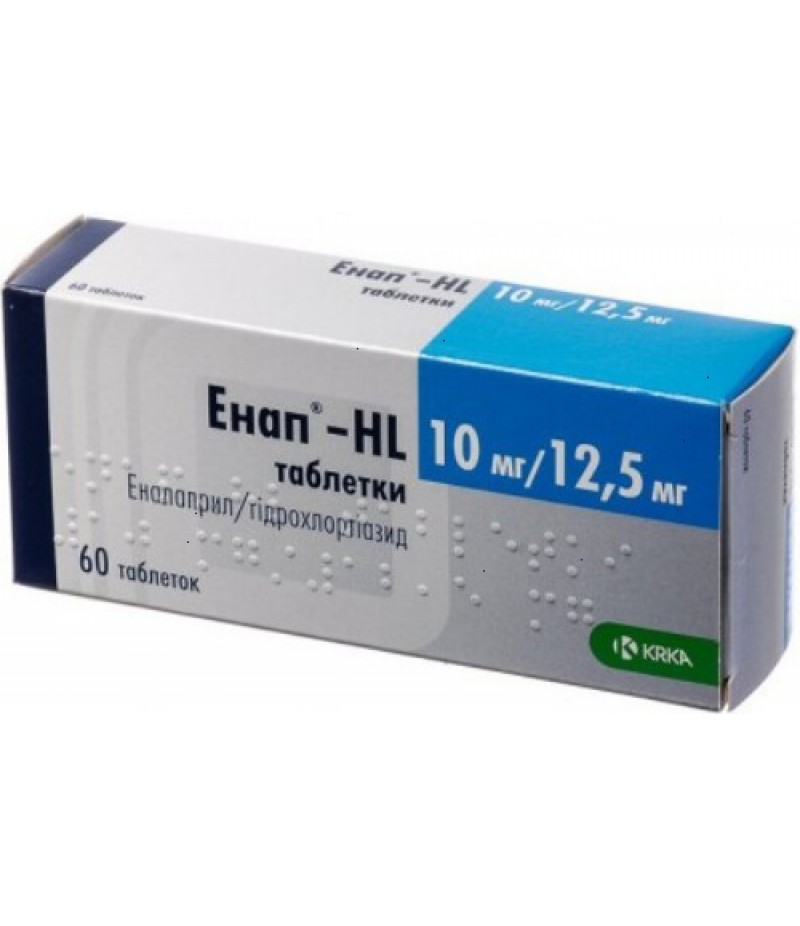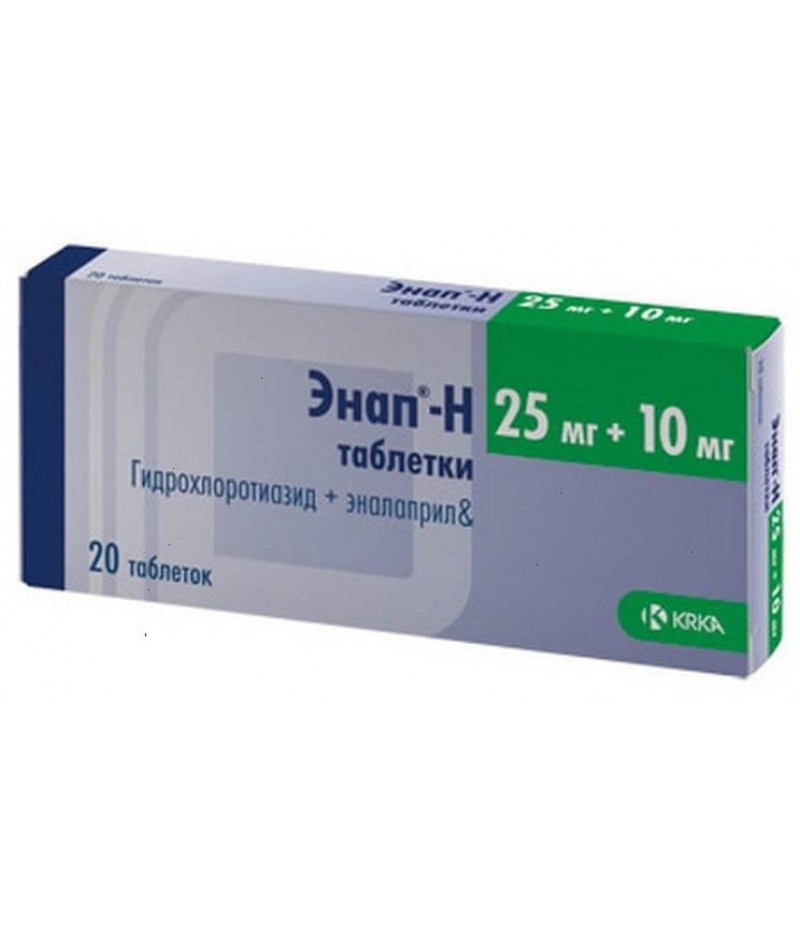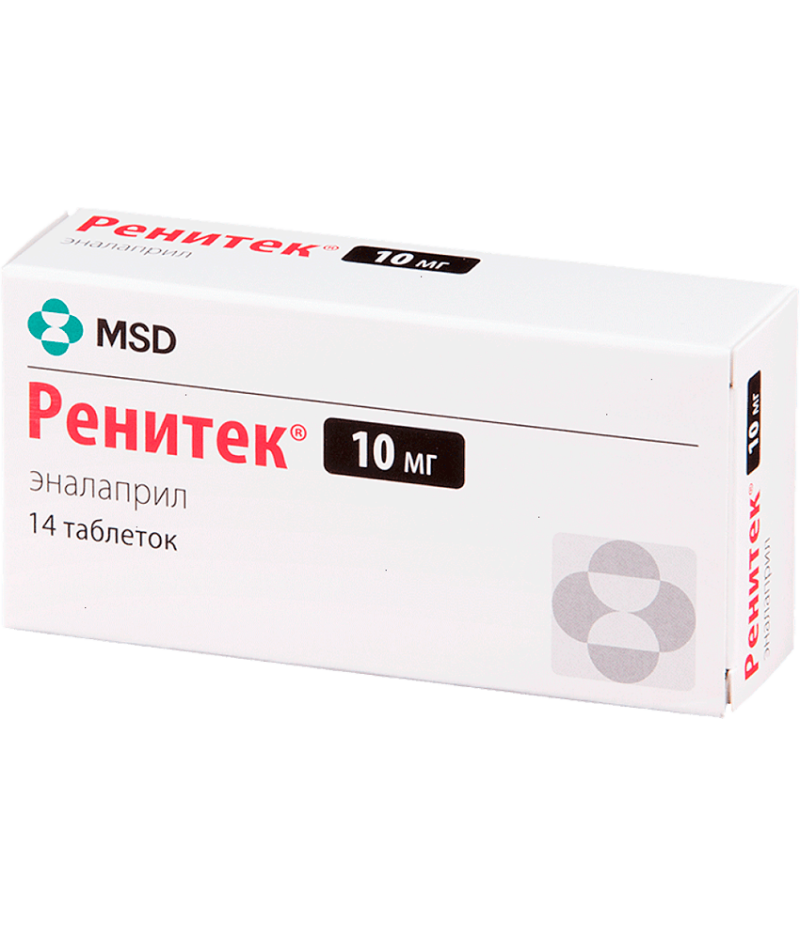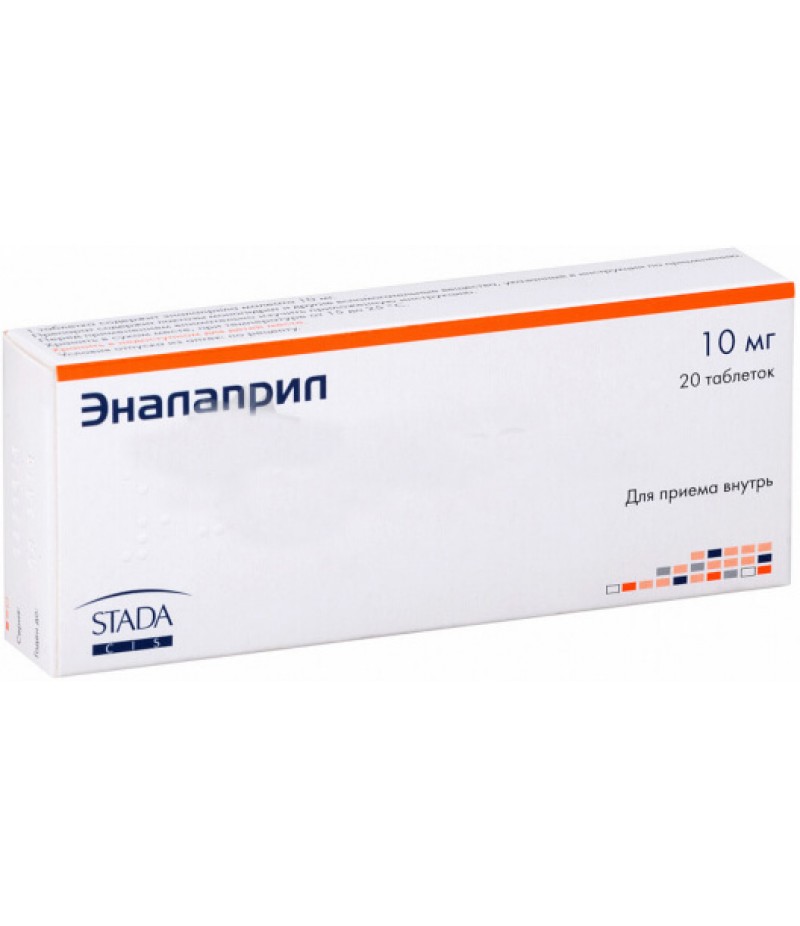Enap-HL tabs 10mg + 12.5mg #60
- $30.28
- 3 or more $29.99
- Availability:In Stock
Enap-HL instruction for useReed more and buy Enap-HL onlineSee also - Enap-H and EnapComposition1 tablet Enap HL includes 12.5 mg of hydrochlorothiazide and 10 mg or 20 mg of enalapril maleate - the active ingredients.Additional i..
Tags: tabs
Enap-HL instruction for use
Reed more and buy Enap-HL online
Composition
1 tablet Enap HL includes 12.5 mg of hydrochlorothiazide and 10 mg or 20 mg of enalapril maleate - the active ingredients.
Additional ingredients: sodium bicarbonate, anhydrous dibasic calcium phosphate, lactose monohydrate, talc, corn starch, magnesium stearate.
Form of issue
The given preparation is issued in the form of tablets of two dosages Enap HL 12,5 mg + 10 mg and Enap HL 12,5 mg + 20 mg (Enap-HL 20), 20 pieces per package.
pharmachologic effect
Antihypertensive.
Pharmacodynamics and pharmacokinetics
Enap HL is a combined antihypertensive drug, the increased effectiveness of which is due to the two active ingredients that make up the tablets.
Enalapril belongs to the group of drugs of ACE inhibitors that interfere with the biosynthesis of angiotensin II from angiotensin I, reduce the plasma content of aldosterone, increase the release of renin by granular cells of the walls of arterioles of the glomeruli of the kidneys, improve the work of the kallikrein kinin system, activate the release of the relaxing endothelial factor (NO) and prostaglandins, suppress the functionality of the sympathetic nervous system.
The joint effects of all these factors contribute to the expansion of peripheral arteries, the elimination of their spasm, the reduction in OPSS, diastolic and systolic pressure, pre- and post-loading on the heart muscle. Expansion of the artery in comparison with the veins occurs to a greater extent, but does not affect the reflex increase in heart rate. The antihypertensive effect of enalapril is more pronounced with a high content of plasma renin. Lowering blood pressure within the therapeutic norms does not affect the blood circulation of the brain. Enalapril has a beneficial effect on the blood supply of ischemic areas of the myocardium, increases blood flow in the kidneys, without affecting GFR (glomerular filtration rate).
The maximum effectiveness of enalapril is observed after a lapse of 6-8 hours and remains at the achieved level for up to 24 hours.
Hydrochlorothiazide belongs to the group of thiazide diuretics, which have an average diuretic effect. Its effects are expressed by a decrease in the reabsorption of sodium ions in the cortical portion of the Henle loop, without affecting its segment passing through the renal cerebral layer. Hydrochlorothiazide in the proximal part of the convoluted tubules blocks the carbonic anhydrase, increases the renal excretion of potassium ions, phosphates and hydrocarbonates. In fact, it does not affect the blood acid-base balance. It increases the excretion of magnesium ions from the body and inhibits the excretion of calcium ions.
Diuretic (diuretic) action develops throughout 1-2 hours, reaches maximum efficiency after 4 hours and lasts for 10-12 hours. The productivity of the diuretic effect decreases as the GFR decreases and reaches zero value at a value less than 30 ml / min. Hydrochlorothiazide has an antihypertensive effect due to a change in the reactivity of the walls of the vessels and a decrease in the BCC.
The combined effects of enalapril and hydrochlorothiazide enhance the antihypertensive effect of Enap-HL, which allows one to observe the effectiveness of therapy for a minimum of 24 hours.
Absorption of enalapril after oral intake (regardless of food) equals 60%. Hepatic metabolism leads to the formation of enalaprilat (active metabolite), which has a stronger inhibitory effect on ACE than enalapril. Plasma Cmax of enalapril is observed after 60 minutes, enalaprilata - after 3-4 hours.
Enalaprilat easily passes through the histohematological barriers, with the exception of the BBB, penetrates in some quantity through the placenta and into the milk of the nursing mother. The relationship of enalaprilat with plasma proteins is at the level of 50-60%.
Renal clearance of enalapril is 18 l / h, its active metabolite is 8.1-9.5 l / h. T1 / 2 enalaprilata is equal to 11 hours. The primary route of excretion is 60% in the urine, 40% in the form of enalaprilate and 20% in the form of enalapril. With fecal masses is deduced by 33%, of them by 27% in the form of enalaprilat and 6% in the form of enalapril.
Removed during peritoneal dialysis and hemodialysis (at a rate of 38-62 ml / min), while the serum content of enalaprilat is reduced by 45-57%.
In pathologies with renal function, excretion takes place at a slowed pace, which requires a reduction in its dosages in accordance with QC (creatinine clearance).
In liver pathologies, metabolic slowdown was observed without changes in pharmacodynamics.
With CHF, the slowing of absorption and metabolic transformations, as well as a decrease in Vd, were noted.
The absorption of hydrochlorothiazide mainly occurs in the proximal part of the small intestine and the duodenum. Absorption is equal to 70% (with food intake increases by 10%). Bioavailability is 70%. Plasma Cmax is observed after 1.5-5 hours.
Vd hydrochlorothiazide is 3 l / kg. The connection with plasma proteins is 40%. When taking therapeutic daily dosages, the average AUC increases in proportion to the increase in doses. Has a minimal cumulation, penetrates through the placenta and into the milk of the nursing mother, accumulates in the amniotic fluid. The content of hydrochlorothiazide in the blood of the umbilical vein actually coincides with the content in the mother's blood. The concentration of hydrochlorothiazide in the amniotic fluid is 19 times higher than the plasma concentration.
Does not lend itself to hepatic metabolism. In the unchanged state, 95% is excreted in the urine and approximately 4% in the form of 2-amino-4-chloro-m-benzene disulfonamide (hydrolyzate), by tubular secretion and glomerular filtration.
Kidney clearance is approximately 335 ml / min. Characterized by a two-phase withdrawal profile. In the initial phase of T1 / 2 about 120 minutes, in the final phase (after 10-12 hours) about 10 hours.
When receiving hydrochlorothiazide in elderly patients, the pharmacokinetics of enalapril did not change, but there was an increase in its serum concentration.
In CHF, hydrochlorothiazide absorption is reduced by 20-70%, corresponding to the severity of the disease, and T1 / 2 is prolonged to 28.9 hours. The average index of renal clearance is 77 ml / min.
When surgery on the intestines for obesity (shunting), there may be a decrease in hydrochlorothiazide absorption by 30%, as well as a decrease in its serum concentration by 50%.
The combined use of enalapril and hydrochlorothiazide does not affect the pharmacokinetics of each drug individually.
Indications for use
Treatment of hypertension (hypertension) in patients with indications for combined therapy.
Contraindications
The purpose of Enap HL is contraindicated when:
Addison's disease;
hypersensitivity to enalapril, hydrochlorothiazide or other additional ingredients of drugs;
the expressed disturbances of a renal function and anuria (at KK less than 30 ml / mines);
primary hyperaldosteronism;
angioedema in anamnesis (of any origin);
porphyria;
under the age of 18 years.
The purpose of the HL Enap should be done with caution when:
gout;
stenosis of the renal arteries;
hyperkalemia;
pathologies of the kidneys (with QC 30-75 ml / min);
diabetes mellitus;
hypertrophic idiopathic subaortal stenosis or severe stenosis of the aortic aorta;
conditions after renal transplantation;
cerebrovascular disorders (including cerebral circulatory insufficiency);
chronic heart failure;
ischemic heart disease;
systemic autoimmune diseases of connective tissue (including scleroderma and lupus erythematosus);
severe hepatic impairment;
suppressed bone marrow hematopoiesis;
states with an observed decrease in BCC (due to therapy with diuretics, salt-free diet, vomiting, diarrhea);
in old age.
Side effects
CNS:
ataxia;
feeling of anxiety;
depression;
drowsiness / insomnia;
increased nervousness;
peripheral neuropathy (dysesthesia, paresthesia).
The cardiovascular system:
orthostatic hypotension;
heart rhythm disturbances;
a feeling of palpitations;
marked decrease in blood pressure;
heart failure;
cerebrovascular stroke;
myocardial infarction;
angina pectoris;
necrotizing angiitis;
Raynaud's syndrome.
Digestive system:
glossitis;
nausea;
dryness in the oral cavity;
stomatitis;
vomiting;
anorexia;
diarrhea;
inflammation of the salivary glands;
constipation;
ileus;
flatulence;
intestinal colic;
pain in epigastrium;
pancreatitis;
jaundice;
liver failure;
melena;
hepatitis.
Respiratory system:
pneumonia;
rhinitis;
asthma;
sinusitis;
hoarseness;
pharyngitis;
bronchospasm;
pulmonary infiltrates;
pulmonary embolism;
eosinophilic pneumonia;
Respiratory distress (including pulmonary edema and pneumonitis);
infarct of the lung.
Genitourinary system:
kidney failure;
oliguria;
weakening of renal function;
gynecomastia;
interstitial nephritis;
lowering the potency.
Sense organs:
lacrimation;
impaired vision;
flavor changes;
impaired sense of smell;
conjunctivitis;
noise in ears;
dryness of the conjunctiva.
The system of hematopoiesis:
hypogemoglobinemia;
leukocytosis;
anemia;
eosinophilia;
leukopenia;
pancytopenia;
neutropenia;
agranulocytosis.
Metabolism:
hyperbilirubinemia;
hypokalemia;
hypertriglyceridemia;
hyperkalemia;
hypercholesterolemia;
hypomagnesemia;
hyperuricemia;
hypercalcemia;
glucosuria;
hyponatremia;
hyperglycemia;
hypochloraemic alkalosis;
increase in the level of liver enzymes.
Skin:
alopecia;
rash;
hyperhidrosis;
shingles.
Allergic manifestations:
erythema multiforme;
itching of the skin;
hives;
exfoliative dermatitis;
skin rash;
photosensitivity;
toxic epidermal necrolysis;
Stevens-Johnson syndrome;
hypersensitivity reactions (thrombocytopenic purpura, angioedema), anaphylactic reactions.
Others:
fever;
sensation of weakness;
lupus-like syndrome (skin rash, fever, eosinophilia, arthralgia and myalgia, serositis, increased ESR, vasculitis, leukocytosis, positive test for antinuclear antibodies).
Enap HL, instructions for use (Method and dosage)
As a rule, the therapy of arterial hypertension does not begin with the intake of combined drugs, but use monotherapy. However, in the case where the effect of a single ingredient of the drug is not enough and the patient is shown treatment with an additional diuretic intake, it is possible to switch to the use of combined drugs. To do this, it is best to initially determine the appropriate dosage of individual ingredients of such a drug and only then select a drug that meets these criteria. Doses of both components are always selected individually for each individual patient.
Enap HL is designed for a single daily (1 tablet in 24 hours) application. The drug should be taken regularly, preferably at the same time of day (preferably in the morning). Tablets should be swallowed whole in the process of eating or after it and washed down with 100-200 ml of water. The duration of therapy is not limited.
If you miss the usual time of taking the nearest dose of Enap HL, the next pill is taken as soon as possible, but only if the time interval before the next intake is sufficiently large. If there is little time left before the usual dose of the next dose (several hours), then this pill is taken and continued therapy in the usual mode. Doubling the daily dosage is not recommended.
In the case when the reception of Enap HL tablets does not lead to a satisfactory therapeutic effect, it is recommended to increase doses, add other drugs or revise the treatment regimen (possibly using other drugs).
In order to prevent the emergence of symptomatic hypotension, patients undergoing treatment with diuretics are advised to undergo a cancellation or reduce the dose in the course of switching to Enap HL for 3 days. Also, before starting the Enap HL tablets, kidney function tests should be performed.
With pathologies of the kidneys of an average nature (QC greater than 30 ml / min), adjustment of the dose of Enap HL is not required.
Overdose
Overdose Enap HL observed increased diuresis, convulsions, a marked decrease in blood pressure with heart rhythm disturbances (for example, bradycardia), paresis, impaired consciousness (up to coma), paralytic ileus, kidney failure, acid-base balance disorders and blood electrolyte balance.
In light toxic cases, gastric lavage is shown with sorbent administration. In more severe conditions, measures to stabilize blood pressure, including intravenous administration of plasma substitutes and saline solution, are recommended. All procedures are performed against the background of monitoring diuresis, respiratory rate, blood pressure, heart rate, serum electrolyte, creatinine and urea levels. In particularly severe cases, IV administration of angiotensin II and a hemodialysis session are indicated.
Interaction
The combined use with other antihypertensive drugs, tricyclic antidepressants, barbiturates, narcotics, phenothiazine and ethanol increases the antihypertensive efficacy of Enap-HL.
Caution should be exercised when taking lithium preparations simultaneously, since Enap-HL inhibits its excretion. This combination of drugs can cause lithium intoxication. In case of such a joint application, it is necessary to monitor the serum concentration of lithium.
Parallel use of NSAIDs, analgesics, Colestipol, Colestyramine, and a large amount of salt in the diet reduce the action of Enap-HL. Also, analgesics and NSAIDs increase the risk of kidney pathology and worsen the picture of heart failure.
Joint reception with potassium-sparing diuretics (including Triamteren, Amyloride, Spironolactone), as well as adding to the diet of potassium, can cause the development of hyperkalemia.
The combined use of immunosuppressants, systemic glucocorticoids, cytostatics and allopurinol can lead to the formation of pancytopenia, anemia or leukopenia. In this case, the periodic conduct of the hemogram is shown.
When used in parallel with oral hypoglycemic drugs, sulfonylurea derivatives and sulfonamides, hypersensitivity reactions due to cross-reaction were more often observed.
Simultaneous reception with cardiac glycosides can cause hypomagnesemia, hypokalemia, hydrochlorothiazide-induced hypovolemia, and also increase the toxicity of glycosides.
Joint appointment with glucocorticoids increases the possibility of hypokalemia.
With simultaneous application of Enap-HL and Cimetidine, T1 / 2 enalapril may increase.
With the combination of Enap-HL and Teofillin, a decrease in T1 / 2 of the latter is possible.
The risk of developing arterial hypotension increases during general anesthesia or the combined use of nondepolarizing muscle relaxants.
There are reports of two cases of acute renal failure after transplantation and postoperative therapy with simultaneous use of Cyclosporine and Enalapril. Presumptive development of this condition was due to a decrease in the blood flow of the kidneys caused by cyclosporine and a decrease in glomerular filtration caused by Enalapril. In this regard, with the parallel use of these two drugs, caution is necessary.
Terms of sale
To buy Enap-HL you don't need a prescription.
Storage conditions
Mode of temperature storage of tablets should not exceed 25 ° C.
Shelf life - 2 years.
special instructions
In patients with hyponatremia, cardiac and renal insufficiency in severe form, left ventricular dysfunction, arterial hypertension, and especially in patients with hypovolemia due to diarrhea, diuretics, vomiting, salt-free diet or hemodialysis, after taking the first dose of Enap-HL observed arterial hypotension, passing with all clinical manifestations.
As a rule, such hypotension, and even more serious consequences, is a rare and transient phenomenon. Before the appointment of Enap-HL, in order to avoid the development of arterial hypotension, diuretics should be canceled, the salt-free diet should be abandoned and, if possible, the other factors affecting the dehydration of the organism should be excluded.
At the first signs of hypotension, the patient should be placed on his back so that his head is below his legs. If necessary, regulate the volume of plasma by infusion of saline and internal intake of a large amount of fluid. Symptoms of transient hypotension can not be considered a contraindication to the further use of Enap-HL, since after normalizing blood pressure and compensating for bcc, further treatment usually passes without such complications.
Caution of use is necessary in relation to patients with impaired renal function (with KK 0.5-1.3 ml / s), in view of possible cumulation of the drug. If necessary, a combination of enalapril with a lower dosage of hydrochlorothiazide or a substitute drug may be recommended.
Sometimes, when hydrochlorothiazide was used, the development of azotemia was observed.
It is necessary to avoid the appointment of Enap-HL therapy for any stenosis of the arteries of the kidneys, because of the possible deterioration of their function, up to acute renal failure (the effect of enalapril). Also throughout the ongoing therapy should monitor the condition of the kidneys.
Caution in the use of ENAP-HL is required in pathologies such as severe cerebrovascular disease, IHD, severe atherosclerosis, aortic stenosis, or any other stenosis that impedes the flow of blood from the left ventricle, as well as in old age, due to the risk of hypotension and deterioration in supply blood of the heart, kidneys and brain.
During treatment, the serum electrolyte content is subject to regular monitoring, in order to timely detect possible imbalance and its subsequent docking. Also, determination of serum electrolyte content is necessary in patients receiving infusion infusions, who suffer from vomiting or prolonged diarrhea.
When treating Enap-HL, one should constantly pay attention to the symptoms of electrolyte imbalance, which can be marked by dryness in the oral cavity, nausea, thirst, oliguria, drowsiness, vomiting, agitation, weakness, lowering of blood pressure, lethargy, tachycardia, muscle pains and cramps (usually gastrocnemius muscles).
During the period of therapy, hypercalcemia and hypomagnesemia, formed as a result of inhibition of calcium excretion and an increase in magnesium excretion (exposure to hydrochlorothiazide), may occur.
A significant increase in serum calcium levels may be a symptom of stealthily developing hyperparathyroidism.
Enap-HL is cautiously prescribed for patients with insufficient hepatic function or progressive liver pathologies, in view of the fact that taking hydrochlorothiazide can lead to hepatic coma even with minor electrolyte imbalance.
As a result of the effects of hydrochlorothiazide, hyperuricemia or gout progression was observed in some patients. In case of an increase in serum uric acid level, the taking of tablets is stopped, with the possible resumption of therapy after optimization of laboratory parameters. Subsequently, such patients need constant monitoring of these indicators.
Patients who undergo treatment with insulin or oral hypoglycemic drugs need careful administration of the drug, since enalapril may potentiate, and hydrochlorothiazide may weaken their effects. It is necessary to more often examine patients suffering from diabetes, as well as adjust dosages of hypoglycemic agents.
Observed angioedema in the neck or face area is usually stopped by cancellation of treatment and prescription of antihistamines. Severe cases of this condition (swelling of the larynx, pharynx, tongue) are amenable to treatment with epinephrine. If it is necessary to maintain patency of the respiratory tract, intubation or laryngotomy is performed.
After carrying out sympathectomy, the hypotensive efficacy of Enap-HL may increase.
Because of the increased risk of anaphylactic reactions, the appointment of Enap-HL to patients who undergo permanent hemodialysis sessions using polyacrylonitrile membranes, patients undergoing apheresis with dextran sulfate and before the procedure of desensitization to bee or aspen venom should be avoided.
Against the background of the use of ACE inhibitors, deterioration of SLE flow was noted.
When conducting Enap-HL therapy, hypersensitivity reactions may occur even without previous bronchial asthma or allergies.
In the treatment of ACE inhibitors, several episodes of acute liver insufficiency with cholestatic jaundice have been reported, with further necrosis of the liver, and as a consequence, with a fatal outcome. The reason for these incidents is unknown. In the case of jaundice formation and an increase in the activity of liver enzymes, it is necessary to cancel treatment and monitor the patient.
In connection with the possibility of cross-sensitivity reactions, it is necessary to use Enap-HL with caution in patients undergoing therapy with sulfonamides or oral hypoglycemic drugs from the sulfonylurea group.
During therapy, it is necessary to periodically carry out studies of the number of leukocytes, especially in patients with kidney or connective tissue pathologies.
During surgical operations or general anesthesia (anesthesia) with the use of antihypertensive drugs, enalapril can block the production of angiotensin II in response to the compensatory yield of renin. In the case when the decrease in blood pressure is explained by this mechanism of action, its correction can be performed by increasing the BCC.
During the therapy, it is necessary to periodically check the serum content of creatinine, electrolytes, urea, glucose and liver enzyme activity, as well as urine protein.
When the procedure for investigating the functionality of the parathyroid glands is appointed, the Enap-HL reception is discontinued.
It is worth to be cautious about carrying out subtle or dangerous works, as well as to driving vehicles, especially at the beginning of treatment.
Children
The experience of using Enap-HL in childhood is not sufficient for its use up to 18 years.
With alcohol
Alcoholic beverages can increase the antihypertensive efficacy of Enap-HL.
During pregnancy (and lactation)
Application of Enap-HL during these periods is contraindicated.
Reviews
All preparations of antihypertensive action are selected strictly in an individual order, that is, the same drug may not be suitable for one patient at all and completely suitable for another. If you take into account the reviews about Enap-HL of those patients, whose body tolerates active and additional ingredients of the drug, has adequate metabolism and is resistant to possible side reactions, then the effectiveness of Enap-HL does not cause any doubts. Otherwise, another antihypertensive drug should be selected, especially since existing analogues for this purpose are abundant.







